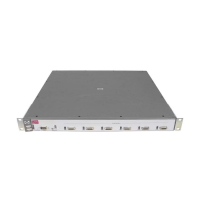IP Routing Features
Configuring DHCP Relay
Configuring DHCP Relay
Overview
The Dynamic Host Configuration Protocol (DHCP) is used for configuring
hosts with IP address and other configuration parameters without human
intervention. The protocol is composed of three components: the DHCP client,
the DHCP server, and the DHCP relay agent. The DHCP client sends broadcast
request packets to the network, the DHCP servers respond with broadcast
packets that offer IP parameters, such as an IP address for the client. After
the client chooses the IP parameters, communication between the client and
server is by unicast packets.
The function of the DHCP relay agent is to forward the DHCP messages to
other subnets so that the DHCP server doesn’t have to be on the same subnet
as the DHCP clients. The DHCP relay agent transfers the DHCP messages from
DHCP clients located on a subnet without DHCP server, to other subnets. It
also relays answers from DHCP servers to DHCP clients.
DHCP Packet Forwarding
The DHCP relay agent on the routing switch forwards DHCP client packets to
all DHCP servers that are configured in the table administrated for each VLAN.
Unicast Forwarding
The packets are forwarded using unicast forwarding if the IP address of the
DHCP server is a specific host address. The DHCP relay agent sets the
destination IP address of the packet to the IP address of the DHCP server and
forwards the message.
Broadcast Forwarding
The packets are forwarded using broadcast forwarding if the IP address of the
DHCP server is a subnet address or IP broadcast address (255.255.255.255).
The DHCP relay agent sets the DHCP server IP address will be set to broadcast
IP address and forwarded to all VLANs with configured IP interfaces (except
the source VLAN).
11-73

